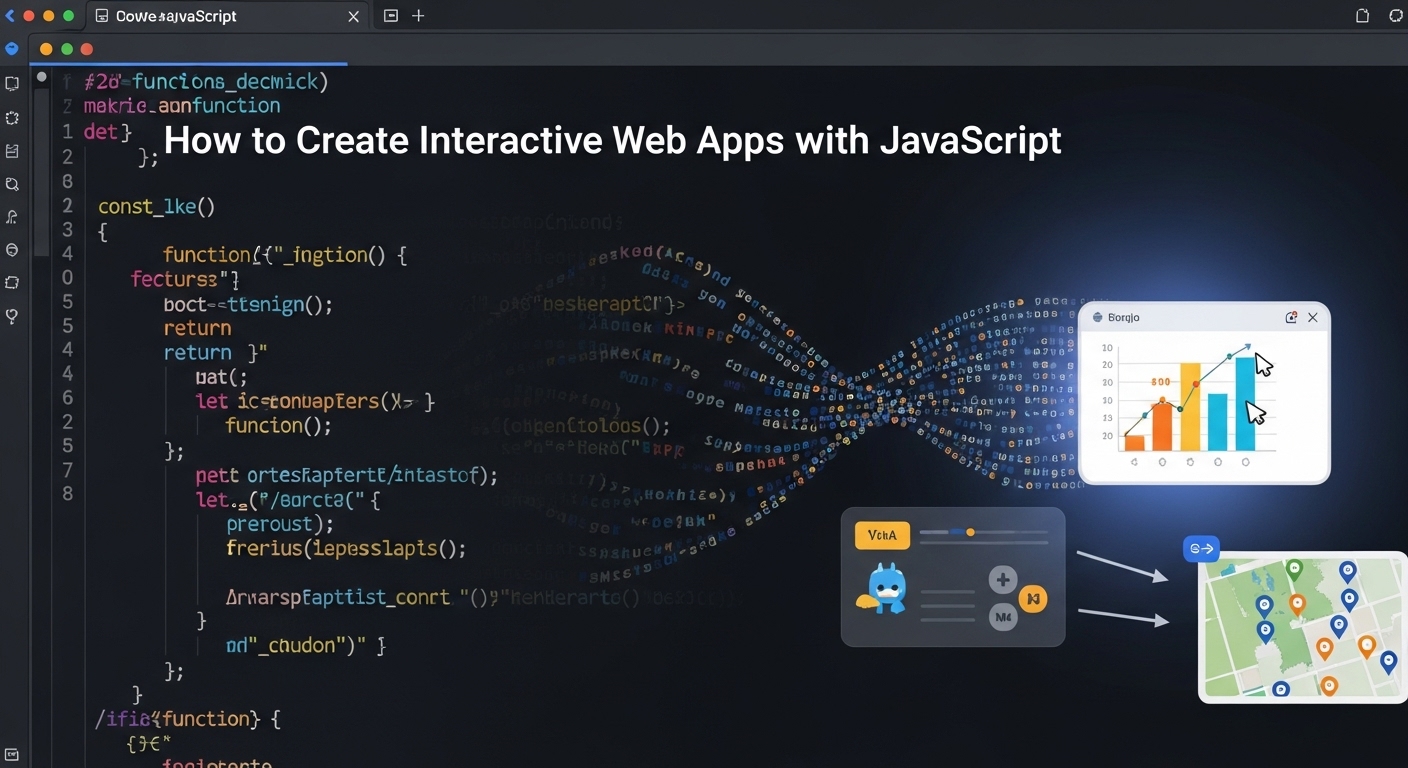When you think about the web applications that capture your attention and keep you engaged, what makes them stand out? The answer lies in their interactivity—the seamless way they respond to your clicks, adapt to your inputs, and provide instant feedback. Creating interactive web apps with JavaScript has become an essential skill for modern web developers, and understanding this process can transform static websites into dynamic, engaging experiences.
Understanding Interactive Web Applications
Interactive web applications go far beyond simple static pages. They respond to user input in real-time, provide dynamic content updates, and create engaging user experiences without requiring page reloads. But before we dive into the technical implementation, let me ask you this: What specific type of interactivity are you hoping to achieve in your web projects?
The foundation of interactive web apps rests on three core technologies working in harmony: HTML provides structure, CSS handles presentation, and JavaScript brings everything to life through behavior and interactivity.
Step 1: Master DOM Manipulation for Interactive Web Apps
The Document Object Model (DOM) serves as your gateway to create interactive web apps with JavaScript. Think of the DOM as a live representation of your HTML that JavaScript can read and modify in real-time.
Essential DOM Methods
// Selecting elements
const button = document.getElementById('myButton');
const elements = document.querySelectorAll('.interactive-element');
// Modifying content
button.textContent = 'Click me for interaction!';
element.innerHTML = '<strong>Dynamic content updated!</strong>';
// Changing styles
element.style.backgroundColor = '#007bff';
element.classList.add('active-state');
Here’s a practical question to consider: How might you use these DOM methods to create a simple interactive calculator? The key is understanding that every user interaction starts with selecting the right elements and then modifying their properties or content.
Step 2: Event Handling – The Heart of JavaScript Interactivity
Events are what make web applications truly interactive. When users click buttons, type in forms, or scroll through content, they’re triggering events that your JavaScript can capture and respond to.
Common Interactive Events
Event Type | Description | Use Case |
click | User clicks an element | Buttons, links, interactive cards |
input | User types or changes form input | Real-time form validation |
mouseover | Mouse hovers over element | Tooltips, hover effects |
scroll | User scrolls the page | Infinite scroll, animations |
keydown | User presses a key | Keyboard shortcuts, games |
// Event listener for interactive button
document.getElementById('interactiveBtn').addEventListener('click', function(event) {
event.preventDefault();
console.log('Creating interactive experience...');
// Add your interactive logic here
});
What types of events would be most important for the interactive web app you’re planning to build?
Step 3: Building Dynamic User Interfaces
To create interactive web apps with JavaScript effectively, you need to master dynamic UI updates. This involves changing content, showing and hiding elements, and updating the interface based on user actions.
Dynamic Content Updates
Consider how popular web applications like GitHub update their interfaces without page reloads. Here’s how you can implement similar functionality:
function updateUserInterface(data) {
const contentArea = document.getElementById('dynamic-content');
// Create interactive elements dynamically
const newElement = document.createElement('div');
newElement.className = 'interactive-card';
newElement.innerHTML = `
<h3>${data.title}</h3>
<p>${data.description}</p>
<button onclick="handleInteraction('${data.id}')">Interact</button>
`;
contentArea.appendChild(newElement);
}
Step 4: Form Validation and User Input Handling
Interactive web applications excel at providing immediate feedback to users. Form validation represents one of the most common and important interactive features you’ll implement.
function createInteractiveFormValidation() {
const emailInput = document.getElementById('email');
const errorMsg = document.getElementById('email-error');
emailInput.addEventListener('input', function() {
const email = this.value;
const isValid = /^[^\s@]+@[^\s@]+\.[^\s@]+$/.test(email);
if (!isValid && email.length > 0) {
errorMsg.textContent = 'Please enter a valid email address';
errorMsg.style.display = 'block';
this.style.borderColor = '#dc3545';
} else {
errorMsg.style.display = 'none';
this.style.borderColor = '#28a745';
}
});
}
How might you extend this validation pattern to create a more comprehensive interactive form experience?
Step 5: AJAX and Asynchronous Programming
Modern interactive web apps rely heavily on asynchronous operations to fetch data without disrupting the user experience. The Fetch API has become the standard for handling these operations.
async function createInteractiveDataExperience() {
try {
const response = await fetch('https://jsonplaceholder.typicode.com/posts/1');
const data = await response.json();
// Update UI with fetched data
document.getElementById('post-title').textContent = data.title;
document.getElementById('post-body').textContent = data.body;
// Add interactive loading states
document.getElementById('loading-spinner').style.display = 'none';
document.getElementById('content-area').style.display = 'block';
} catch (error) {
console.error('Error creating interactive experience:', error);
// Handle error state interactively
showErrorMessage('Failed to load content. Please try again.');
}
}
Step 6: Leveraging JavaScript Frameworks and Libraries
While vanilla JavaScript provides the foundation to create interactive web apps with JavaScript, modern frameworks can significantly accelerate development and provide powerful tools for complex interactions.
Popular Framework Options
React: Excels at creating interactive user interfaces through component-based architecture. React’s official documentation provides comprehensive guides for interactive development.
Vue.js: Offers a gentle learning curve while providing powerful reactive features for interactive applications.
Angular: Provides a full-featured framework ideal for large-scale interactive web applications.
// React example for interactive component
function InteractiveCounter() {
const [count, setCount] = React.useState(0);
return (
<div className="interactive-counter">
<h2>Interactive Counter: {count}</h2>
<button onClick={() => setCount(count + 1)}>
Increase Interactivity
</button>
</div>
);
}
Which framework aligns best with your current skill level and project requirements?
Step 7: Optimizing Performance and User Experience
Creating smooth, responsive interactive web apps requires attention to performance optimization. Users expect immediate feedback and seamless interactions.
Performance Best Practices
// Debounce function for search input
function debounce(func, delay) {
let timeoutId;
return function (...args) {
clearTimeout(timeoutId);
timeoutId = setTimeout(() => func.apply(this, args), delay);
};
}
// Optimized search functionality
const optimizedSearch = debounce(function(query) {
// Perform search operation
searchInteractiveContent(query);
}, 300);
Memory Management and Event Cleanup
Proper event listener management prevents memory leaks in interactive applications:
class InteractiveWidget {
constructor(element) {
this.element = element;
this.handleClick = this.handleClick.bind(this);
this.element.addEventListener('click', this.handleClick);
}
handleClick(event) {
// Interactive click logic
console.log('Creating interactive response...');
}
destroy() {
// Clean up event listeners
this.element.removeEventListener('click', this.handleClick);
}
}
Advanced Interactive Features
As you become more comfortable with the basics, consider implementing these advanced interactive features:
Real-time Updates with WebSockets
function createInteractiveWebSocketConnection() {
const socket = new WebSocket('wss://your-websocket-server.com');
socket.addEventListener('message', function(event) {
const data = JSON.parse(event.data);
updateInteractiveInterface(data);
});
socket.addEventListener('open', function(event) {
console.log('Interactive connection established');
});
}
Progressive Web App Features
Transform your interactive web apps into PWA experiences by implementing service workers and offline functionality. Google’s PWA documentation provides excellent guidance for this enhancement.
Testing Interactive Web Applications
Robust testing ensures your interactive features work reliably across different browsers and devices:
// Unit testing interactive functions
function testInteractiveFeature() {
const mockElement = document.createElement('button');
const interactiveHandler = createInteractiveHandler();
// Test interactive behavior
mockElement.click();
// Assert expected outcomes
console.assert(mockElement.classList.contains('active'), 'Interactive state should be active');
}
Common Challenges and Solutions
When you create interactive web apps with JavaScript, you’ll encounter common challenges. Here are practical solutions:
Browser Compatibility
Use feature detection and polyfills to ensure your interactive features work across all target browsers:
if ('IntersectionObserver' in window) {
// Use modern interactive scroll features
implementInteractiveScrollEffects();
} else {
// Fallback for older browsers
implementBasicScrollDetection();
}
Accessibility Considerations
Interactive web apps must remain accessible to all users:
// Keyboard navigation support
element.addEventListener('keydown', function(event) {
if (event.key === 'Enter' || event.key === ' ') {
handleInteractiveAction();
}
});
// ARIA attributes for screen readers
element.setAttribute('aria-expanded', 'true');
element.setAttribute('role', 'button');
Future Trends in Interactive Web Development
The landscape of interactive web development continues evolving. WebAssembly enables near-native performance for complex interactive applications, while Web Components provide reusable interactive elements. Stay informed about these trends through resources like MDN Web Docs and Can I Use.
Conclusion
Learning to create interactive web apps with JavaScript opens doors to building engaging, dynamic user experiences that keep visitors returning to your applications. Start with DOM manipulation and event handling, then gradually incorporate advanced features like asynchronous programming and modern frameworks.
The journey from static websites to fully interactive web applications requires practice and patience. Begin with small interactive features—perhaps a simple form validator or an image gallery—then expand your skills by tackling more complex challenges.
What interactive feature will you implement first in your next web project? Remember, every expert developer started with a single interactive button or form field. Your interactive web development journey begins with that first line of JavaScript code.











